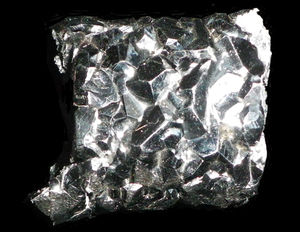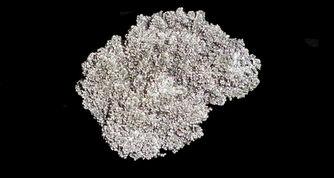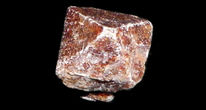Hafnium
 Hafnium crystal bar about 30mm long, but weighing over 200 grams by diddi | |||||
| General properties | |||||
|---|---|---|---|---|---|
| Name, symbol | Hafnium, Hf | ||||
| Appearance | Steel-gray | ||||
| Hafnium in the periodic table | |||||
| |||||
| Atomic number | 72 | ||||
| Standard atomic weight (Ar) | 178.49(2) | ||||
| Group, block | , d-block | ||||
| Period | period 6 | ||||
| Electron configuration | [Xe] 4f14 5d2 6s2 | ||||
per shell | 2, 8, 18, 32, 10, 2 | ||||
| Physical properties | |||||
| Steel-gray | |||||
| Phase | Solid | ||||
| Melting point | 2506 K (2233 °C, 4051 °F) | ||||
| Boiling point | 4876 K (4603 °C, 8317 °F) | ||||
| Density near r.t. | 13.31 g/cm3 | ||||
| when liquid, at | 12 g/cm3 | ||||
| Heat of fusion | 27.2 kJ/mol | ||||
| Heat of | 648 kJ/mol | ||||
| Molar heat capacity | 25.73 J/(mol·K) | ||||
| pressure | |||||
| Atomic properties | |||||
| Oxidation states | 4, 3, 2, 1, −2 (an amphoteric oxide) | ||||
| Electronegativity | Pauling scale: 1.30 | ||||
| energies |
1st: 658.5 kJ/mol 2nd: 1440 kJ/mol 3rd: 2250 kJ/mol | ||||
| Atomic radius | empirical: 159 pm | ||||
| Covalent radius | 175±10 pm | ||||
| Miscellanea | |||||
| Crystal structure | Hexagonal close-packed (hcp) | ||||
| Speed of sound thin rod | 3010 m/s (at 20 °C) | ||||
| Thermal expansion | 5.9 µm/(m·K) (at 25 °C) | ||||
| Thermal conductivity | 23.0 W/(m·K) | ||||
| Electrical resistivity | 331·10-9 Ω·m (at 20 °C) | ||||
| Magnetic ordering | Paramagnetic | ||||
| Young's modulus | 78 GPa | ||||
| Shear modulus | 30 GPa | ||||
| Bulk modulus | 110 GPa | ||||
| Poisson ratio | 0.37 | ||||
| Mohs hardness | 5.5 | ||||
| Vickers hardness | 1520–2060 MPa | ||||
| Brinell hardness | 1450–2100 MPa | ||||
| CAS Registry Number | 7440-58-6 | ||||
| History | |||||
| Naming | After Hafnia (Latin for Copenhagen), where it was discovered | ||||
| Prediction | Dmitri Mendeleev (1869) | ||||
| Discovery and first isolation | Dirk Coster and George de Hevesy (1922) | ||||
Hafnium is a d-block transition metal with the symbol Hf and atomic number 72. It is a hard, high melting point silvery metal, which is resistant to attack by most acids and alkalis. The most documented chemistry revolves around the halides. The principle uses of metallic hafnium are related to the nuclear industry.
Contents
Properties
Chemical
The chemistry of hafnium is dominated by halides. Hafnium (and zirconium) is essentially restricted to IV state which is due to the loss of the 2 d-electrons and the 2 s-electrons. Other oxidation states are rarely observed and generally accepted to be unstable. In native ores, hafnium occurs as the silicate. The oxygen is displaced in furnace conditions by carbon and replaced by chlorine gas to produce the halide [[HfCl4]]. Hafnium halides can be produced by exposing the metal to halide under heat. Most of the halides are volatile solids, but the fluoride is stable. The halides react rapidly to form the oxyhalides HfOX2 which are also stable. The volatility of the tetrahalides is exploited in the production of hafnium "crystal bar" (and also zirconium and titanium crystal bar). Crystal bar production is achieved by reducing the iodide on a platinum wire, resulting in a very high purity metal which forms the beautiful crystal structure.
Hafnium is capable of forming up to 8-coordinate bonding structures, but 7- and 6- coordinate are known as well. This means that complexes of HfX73- and HfX84- are known.
The most important uses of hafnium are due to its nuclear behavior. Hafnium is an excellent neutron absorber and almost all world production is to supply the nuclear industry with the all important control rods required to stop the runaway "melt down" condition where there are too many mobile neutrons in the reactor. Ironically, zirconium is almost transparent to neutrons and is the preferred metal for fuel rod casings. This presents the industrial problem of ensuring that the neutron transparent zirconium is completely free of the highly absorbing hafnium because their nuclear properties are so different.Physical
Hafnium shares a number of characteristics with its d2 cousins Zr and Ti which reside above it in the periodic table. It is quite hard (comparable with molybdenum, but not quite a refractory metal), and has a high melting point of about 2500K which is in the same range as Zr and Ti. In contrast, however, Hf It is very noticeably denser than Zr and even Pb, at about 13 g/cm3. Hafnium, like its cousins, forms a very hard oxide layer which results in specimens have a beautiful shiny silvery surface, which is faintly blue compared pure silver, and about the same hue as cobalt. Hafnium also shares its crystalline structure with its cousins.
Availability
Hafnium is predicted by investment speculators to be depleted in the environment within the next 10 years, and its price is rapidly increasing. The spot price tripled in the years 2007 to 2010 (U.S. Geological Survey) and the metal is increasingly more difficult to source at anywhere near spot prices in the domestic market. There are a number of varieties available including foils, bar, etc and two highly attractive forms, the electrolytic "flower" and the crystal bar, both of which attract a premium.
Isolation
The industrial preparation of hafnium is performed by reduction of the principle ore, zircon (the same as the precious gemstone) ZrSiO4 with carbon.Zirconium and hafnium have very similar atomic radii and as a result there is substitution of zirconium by hafnium in the matrix. Zirconium forms .013% of the Earth's crust (Wolfram Research) whilst hafnium is orders of magnitude scarcer at .00033%. The hafnium is separated from zirconium as a very valuable byproduct. There are no hafnium specific ores. Purification is by electrolytic processes or the crystal bar method.
Small amounts of hafnium can be dissolved out of plasma torch cutting elements, by using sulfuric acid and hydrogen peroxide over the course of several days to free it from the surrounding copper. When finished, each torch element yields a cylinder of hafnium approximately 0.5mm in diameter and 3mm long.
Projects
- Dragon's breath
Handling
Safety
Hafnium metal has similar properties to zirconium, and has little toxicity. Most of its compounds however have shown to be less benign. Hafnium is safe to store in air and suitable for element collector's displays without any precautions. It is nontoxic and poses no risks. Aldrich catalog states that the fine 325 mesh powder is a flammable solid and it is shipped under water. Sponge is not considered flammable.
Storage
Hafnium can be stored in air without any degradation for years, as noted by many elemental collectors.
Disposal
Hafnium and its compounds have little toxicity, though given its rarity, it's best to try and recycle them.

